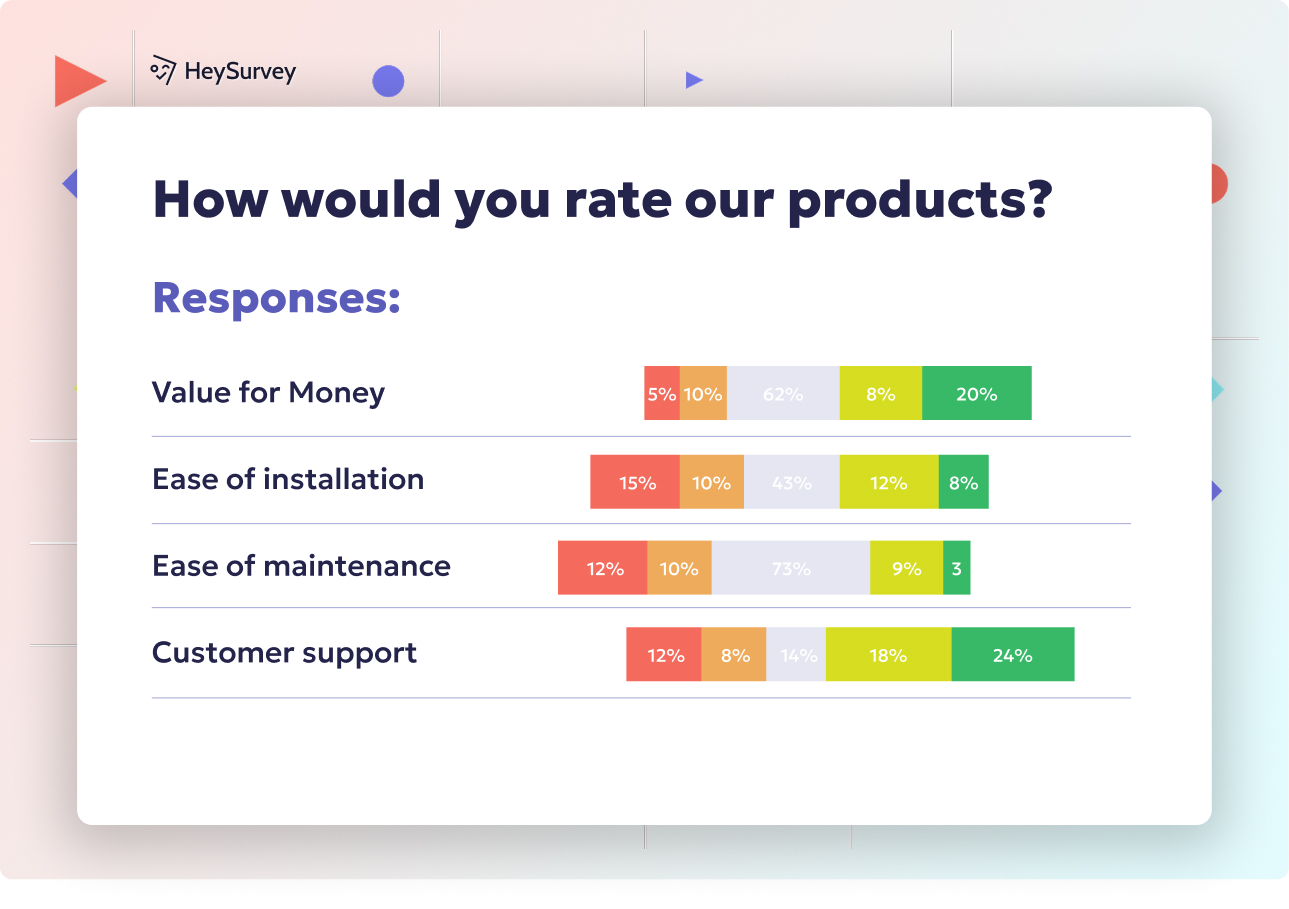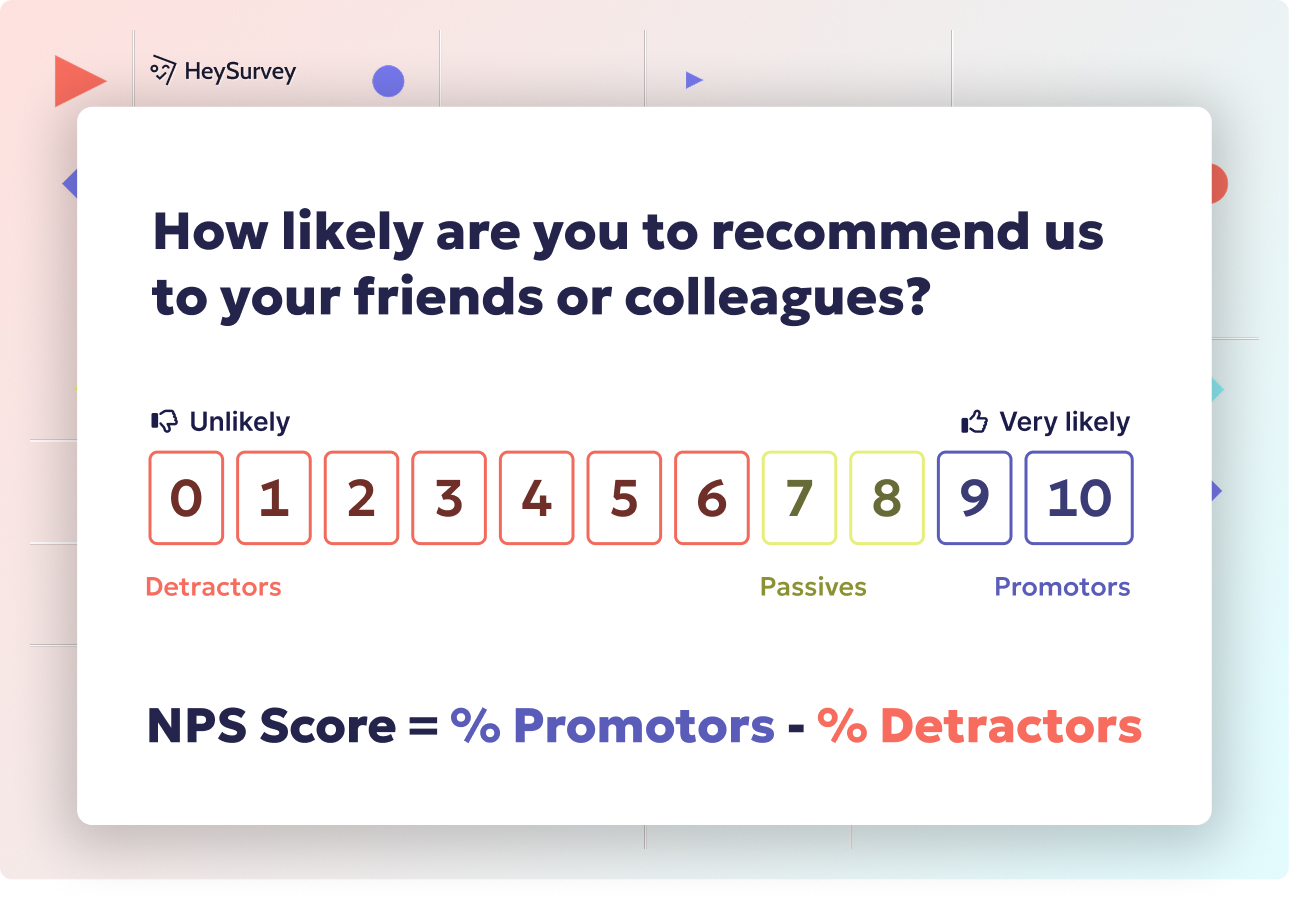30 Survey Questions for Students: 6 Types & When to Use Them
Explore 6 powerful survey types with 30+ sample survey questions for students to boost engagement, well-being, and academic success.
With schools, colleges, and universities striving for improving student experience across all touchpoints, asking the right questions matters more than ever. Student surveys are a creative, data-driven way to empower learners, spot campus trends, and fine-tune everything—from courses to club snacks. From course feedback to career guidance, you’ll find six powerful survey types here, each loaded with high-impact question examples for actionable insights. Ready to level up your next survey? Stick around for a simple best-practices checklist at the end!
Course Feedback Surveys
Why & When to Use This Survey Type
Course feedback surveys are every educator's not-so-secret decoder ring for what’s really working in class. It’s best to hand these out at mid-semester, when students’ memories of assignments and lectures are fresh, and again at the end—while the course is still top of mind, not lost in the summer haze. The power of these surveys is simple: Their responses are gold for shaping the next semester’s experience.
Feedback filters out noise and surfaces what really matters: Is the course moving too quickly? Are students yawning through assessments or raving about resource packs? Use these surveys to check if course objectives make sense, if students find the grading fair, and if the material is paced just right.
Timing-wise, sprinkling a brief survey in the middle of the term opens up a feedback loop. It lets instructors fine-tune and address concerns before finals, making the student journey smoother and, hopefully, more fun.
Here’s when course feedback surveys shine brightest:
After students have completed a major assignment
Post-exam, for real-time stress check-ins
At the very end of the term, just before grades are in
Fine-tuning course content based on real student input is proactive, not reactive. Whether you’re revamping course modules or simply choosing which topics to highlight next semester, these surveys provide the directional compass.
Sample Questions
- How clearly did the instructor explain course objectives?
- Which assignment helped you learn the most, and why?
- On a scale of 1–10, how organized were the course materials?
- What topics would you like expanded or added next term?
- How fair and transparent was the grading system?
- Which reading or resource was the most helpful?
- What suggestions do you have for improving this course for future students?
Instructors who actively promote course evaluations and explain their importance to students can significantly increase response rates and obtain more constructive feedback. (uta.edu)

Creating your student survey with HeySurvey is as easy as 1-2-3! Follow these simple steps to get your survey up and running quickly—no tech degree required.
Step 1: Create a New Survey
Start by logging into HeySurvey (or jump in without an account to start drafting). Click the “Create New Survey” button to open the survey builder. You can either:
- Choose a template to speed things up (highly recommended for student surveys!), or
- Start from scratch with an empty sheet if you want full control.
Once your survey is created, you’ll land in the Survey Editor, ready to customize.
Step 2: Add Your Questions
Hit the “Add Question” button to start building your survey content. Pick from a variety of question types: multiple choice, scales, open text, and more. For student surveys, mix rating scales with open-ended questions to get both numbers and stories. You can:
- Edit question text and descriptions
- Mark questions as required
- Add images or files if needed
- Rearrange questions by dragging them
Feel free to duplicate questions or add branching logic to personalize the student experience based on responses.
Step 3: Publish Your Survey
Once all your questions look good, click “Preview” to test the flow and design. When ready, hit “Publish” to get a shareable link. You’ll need an account to publish, but that lets you collect and analyze responses securely.
Respondents can access your survey from any device—no sweat!
Bonus Steps to Make It Shine
Apply Branding
Customize your survey by uploading your school or department logo. Open the Designer Sidebar to tweak colors, fonts, backgrounds, and animations. This helps make the survey feel on-brand and familiar to your students.
Define Settings
Set your survey’s start/end dates, response limits, or add a redirect URL for when the survey is done. You can also choose to let students view results after completion if that fits your survey style.
Skip Into Branches
Use branching logic for smarter surveys! Send students down different question paths based on their answers. For example, if a student says they haven’t used career services, you can skip that section and save their time.
Ready to get started? Click below to open a student survey template in HeySurvey and begin creating in minutes!
Teaching Style & Engagement Surveys
Why & When to Use This Survey Type
Teaching isn’t one-size-fits-all, and engagement surveys help decode the mystery of what truly captivates a room. These should land after key instructional units, especially when guest lecturers or experimental teaching methods join the party. Many departments also use these for internal peer reviews—sort of like a performance review but with more group projects.
These surveys shine a spotlight on pedagogical flair, class energy, and student motivation. Are lectures interactive, or does the clock tick just a little too loudly? Are group activities and discussions drawing everyone in or creating awkward silences? The only way to really know what clicks is to ask.
Uncover what motivates students to raise their hands, join discussions, and take classroom risks. These insights help educators adjust their teaching style for stronger student connections and better academic outcomes.
Times to deploy engagement surveys include:
After a new teaching method has been tested (think flipped classroom or group presentations)
Following guest lectures, to track impact and relevance
At the end of each instructional unit, for continuous adjustment
Focusing on pedagogical approaches boosts not only academic success but also students' sense of belonging in the classroom. More engagement equals happier, more invested students.
Sample Questions
- How frequently did the instructor encourage class discussion?
- Which teaching method (lecture, group work, flipped classroom) was most effective for you?
- Rate how engaging the in-class activities were.
- What could the instructor do to better support different learning styles?
- Did you feel comfortable asking questions during class? Why or why not?
- What would make class participation more enjoyable for you?
- Were course examples relevant to your interests or future goals?
Implementing active learning strategies in university courses reduces failure rates from 32% to 21% and increases student performance by 0.47 standard deviations. (en.wikipedia.org)
Student Well-Being & Mental Health Surveys
Why & When to Use This Survey Type
Well-being surveys are as essential as any textbook when it comes to student success. These surveys help schools identify stress triggers, counseling needs, early burnout, and whether mental health is really a campus priority or just a tagline. The best time to launch one is either once a semester or right after intense periods, like exam weeks or registration rush.
Students juggle classes, jobs, family, and friends. Sometimes, all the juggling gets a bit too much. By asking directly how students are doing, educators and administrators can spot problems before they escalate and target support where it’s needed most.
These mental health check-ins have become a must in modern education. They uncover not just problems, but also what’s helping students thrive—like yoga in the quad or late-night walk-in counseling.
Choose your timing wisely:
Just after midterms or finals, when nerves are most frazzled
If there’s been a campus incident or widespread change
At the start of the year, to benchmark well-being and track changes
Identifying early signs of burnout means smarter support services and, ultimately, more resilient student communities. Actionable data in the well-being arena shows students you genuinely care.
Sample Questions
- How often do you feel overwhelmed by your workload?
- Which campus resources have you used for mental-health support?
- Rate your current stress level on a 1–5 scale.
- What activities help you maintain a healthy study-life balance?
- Do you feel your institution prioritizes student well-being?
- How easy is it to access counseling services on campus?
- What more could the school do to support your mental health?
Campus Facilities & Services Surveys
Why & When to Use This Survey Type
If you want students to rave—or rant—about campus life, facilities surveys are your best source of feedback. These should be conducted at least once a year and whenever there’s a big change in the environment, like a shiny new dining hall or an upgraded library. Because let’s face it: There’s only so long you can ignore a squeaky dorm washing machine before campus Twitter gets involved.
Feedback from these surveys is the launchpad for every major (and minor) upgrade, from adding gluten-free options to bettering wheelchair access. Schools with top-notch facilities know it’s not just about fancy technology or new couches, but about making sure every student has the resources they need to thrive.
No area of campus is off-limits. Students can rate everything: how often the Wi-Fi drops, the vibe in common areas, or the deliciousness of lunchroom tacos.
Ideal times for these surveys include:
After major renovations or the debut of a new service
Annually, to benchmark changes and progress
In response to recurring complaints or requests
Gathering facility feedback is a proactive move that tells students their everyday experiences matter, not just their grades. Plus, it helps prevent costly mistakes on future projects.
Sample Questions
- How satisfied are you with library study spaces?
- Rate the cleanliness of residence halls.
- How reliable is campus Wi-Fi in classrooms and common areas?
- What additional dining options would you like to see?
- Have you faced any accessibility challenges on campus? Please describe.
- Are tech labs equipped with the tools you need?
- How comfortable and safe do you feel in communal areas?
A nationwide survey by the U.S. Department of Education revealed that 68% of college students are satisfied with their dormitory conditions, though concerns about high fees and maintenance persist. (edgovsc.us.org)
Career Preparation & Guidance Surveys
Why & When to Use This Survey Type
Scoring the dream job starts well before graduation. Career preparation surveys act as reality checks—are students ready for interviews? Are the career fairs helpful, or just free-pen bonanzas? These should roll out before internship season or as students line up to toss their caps in the air.
Rapid changes in job markets and employer expectations mean students need feedback to close gaps in their resume, interview skills, and career planning. These surveys help campus career services focus support where it counts—choosing which workshops to ramp up, or deciding if alumni mentors are making a difference.
Institutions can measure how confident students feel as they leave campus, which services they’ve actually used (not just read about in newsletters), and what’s missing from their job-readiness toolkit.
Ideal survey moments:
Just before major campus recruitment events or internship deadlines
As graduation approaches, to track long-term readiness
After introducing new career-prep programs
Evaluating career-services effectiveness is essential for making sure every resource, from job boards to mock interviews, delivers real value to students. No one wants to discover a gaping skills gap mid-interview.
Sample Questions
- How prepared do you feel for internship or job interviews?
- Which career services have you used (resume workshops, job fairs, mentorship)?
- Rate the usefulness of your academic program in developing employable skills.
- What companies or industries interest you most?
- What additional support would help you reach your career goals?
- How helpful was guidance from your academic advisor or mentor?
- Are you aware of the job placement resources available to you?
Online & Hybrid Learning Experience Surveys
Why & When to Use This Survey Type
Online classes are no longer a novelty, but there are always bugs to squish and connections to strengthen. Online and hybrid learning surveys pinpoint the joys—hello, learning in pajamas!—and the pain points, like glitchy platforms or feeling disconnected halfway across the globe. Run these after students have settled in for a few weeks, or at the end of a fully remote term.
These surveys go beyond asking about the latest tech hiccup. They uncover how easy it is to navigate the learning platform, participate in discussions, and get help when assignments baffle even the savviest students. Isolation, timezone struggles, and survey-fatigue? You’re looking right at them through these questions.
Use these surveys to check in after big shifts—such as a move to hybrid models or new virtual tools. Quick feedback here equals fast fixes and happier virtual classrooms.
When to survey:
After the first few weeks of any online course, while experiences are fresh
Once a remote term or year ends, for a holistic review
If new digital features or platforms are launched mid-year
Pinpointing tech and engagement gaps means smoother digital learning for all. The more connected students feel—both to each other and the material—the better the experience and the outcomes.
Sample Questions
- How intuitive is the learning management system (LMS) interface?
- Rate the clarity of instructions for online assignments.
- What barriers (tech, time zones, distractions) affect your participation?
- How connected do you feel to classmates in the virtual setting?
- Which online tools (breakout rooms, polls, forums) enhanced your learning most?
- How comfortable are you reaching out for help in online classes?
- What would improve your online or hybrid learning experience?
Best Practices: Dos & Don’ts for Student Surveys
Crafting a winning survey is an art and a science. The most memorable surveys respect students’ time, keep it simple, and guarantee anonymous student feedback every single time. Here’s how to field the kind of survey everyone wants to see in their inbox:
Do set clear objectives before drafting questions. Know exactly what insights you want—before you hit “send.”
Do keep surveys concise. Aim for 10–15 minutes max. Anything longer risks losing attention—and honest answers.
Do mix quantitative scales and open-ended questions for richer data. Numbers paint trends, but stories fill in the details.
Don’t use jargon or double-barreled questions. If you confuse students, your data will be as clear as mud.
Don’t ignore anonymity—explain how responses are kept confidential right at the top. Trust is everything.
Do communicate results and planned actions to build trust and boost survey response rate. If students see changes, they’ll believe in the process—and respond next time.
Effective student survey design is all about clarity, simplicity, and respect. Done right, your survey feels like a conversation, not a chore.
Conclusion – Turning Student Insights into Action
Effective student survey questions pave the way for meaningful change in every campus corner. By leveraging all six powerful survey types, schools can pinpoint what’s working—and what’s not. Collect, analyze, act, and repeat: That’s the recipe for continuous improvement. Start your next survey with these question templates and watch student experience soar. Ready to turn student insights into action? Dive in and start building today!
Related Student Survey Surveys

31 Survey Questions Examples for Students to Improve Learning
Discover 28 survey questions examples for students across 6 key types to boost engagement, feedba...

29 Class Survey Questions: Proven Templates for Every Stage
Discover 40+ proven class survey questions with detailed templates for every course stage to boos...

31 Essential Math Survey Questions for Students PDF Guide
Discover over 30 sample math survey questions for students PDF covering anxiety, confidence, stud...

